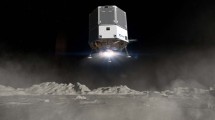Abstract
The Soviet-American competition in space exploration culminated in the Moon race at the threshold of 1960–1970s. It was driven by political motivations and serves as a good lesson for the next generations. After being the leader, the former USSR eventually let the USA win the ambitious program to land a man on the lunar surface. Instead, the Soviets successfully implemented a program of robotic Moon exploration, including the world’s first automatic lunar sample returns and rover operations on the lunar surface. Both Apollo expeditions and robotic missions greatly advanced our knowledge of the Moon and planetary sciences in general.
The International Astronomical Union (IAU) contributed to scientific exploration of our closest neighborhood, astronomers playing an especially important role in the mapping/naming the Moon surface features, and getting insight into the lunar/planetary astronomy, geology and geochemistry. This activity was mostly conducted in the framework of the IAU “Working Group for Planetary System Nomenclature” (WGPSN). The productive work of the WGPSN allowed to identify and select the sites for safe landings on the Moon, and at the same time, to accommodate requirements of scientific interest. It paved the road for the future Moon missions, as well as for missions to other planets. The experience gained at the WGPSN is an invaluable legacy of the international cooperation and in particular, in resolving complicated scientific-cultural and political problems, a key of diplomacy. The author was a member of the WGPSN for several decades, and describes here his own experience and that of colleagues in this group as a good example of astronomers’ actions as diplomats. The author also gives some other illustrations drawn from his personal career, combining professional skills as space physicist/astronomer with diplomatic activities.
Access this chapter
Tax calculation will be finalised at checkout
Purchases are for personal use only
Similar content being viewed by others
Notes
- 1.
LOK and LK are Russian acronyms Lunnyi Orbitalnyi Korabl’ and Lunnyi Korabl’ meaning Lunar Orbiting Vehicle and Lunar Lander, respectively.
- 2.
Basically, the LOK flyby trajectory represented very high elliptical Earth’s orbit with no residence around the Moon.
- 3.
The official decision was taken in 1976.
References
Автоматические космические аппараты для фундаментальных научеых и прикладных исследований, Редакторы Г.М. Полищук и К.М. Пичхадзе. НПО им. Лавочкина, МАИ-Принт, Москва 2010. [Avtomaticheskie Kosmicheskie Apparati dlya Fundamental’nikh Nauchnikh i Prikladnikh Issledovaniy. Redaktori G.M. Polytshuk i K.M. Pichhadze. NPO im. Lavochkina, MAI Print, Moskva 2010: Automatic Space Vehicles for the Fundamental Scientific and Applied Research, 2010, Lavochkin Association, Eds. G.M. Polytshuk and K.M. Pichhadze. MAI-PRINT, Moscow 2010].
Blamont, J. (1987). Venus dévoilée, Voyage autour d’une planète. Editions Odile Jacob.
Виноградов А.П. (Редактор). [Vinogradov, A.P., redactor]. Космохимия Луны и планет. Труды советско-американской конференции по космохимии Луны и планет. НАУКА, Москва, 1975. [Kosmokhimiya Luni i planet. Trudi Sovetsko-Amerikanskoy konferehtsii po kosmokhimii Luni i planet, NAUKA, Moskva, 1975 : Proceedings of the Soviet-American Conference on Cosmochemistry of the Moon and Planets. Vinogradov, A.P., Ed., NAUKA, Moscow, 1975].
Huntress, W. T., & Marov, M. Y. (2011). Soviet Robots in the Solar System. Mission technologies and discoveries. Springer-Praxis.
Келдыш М.В., & Маров М.Я. (1981). Космические исследования. НАУКА, Москва. [Keldysh M.V. and Marov M.Ya.,. Kosmicheskie issledovaniya. NAUKA, Moskva, 1981: Keldysh M.V., and Marov M.Ya. Space Research. NAUKA, Moscow, 1981.]
Космический научный центр ЦНИИМАШ-70. Редакторы Горшков О.А., Анфимов Н.А. и Панишкин Н.Г.. Т.1. Королев-РИНФО, 2016. [Kosmicheskiy Nauchniy Tsentr TSNIIMASH-70/ Redaaktori Gorshkov O.A., Anfimov N.A. i Panichkin N.G. Korolev- RINFO, 2016 : Space Scientific Center TSNIIMASH-70, Eds. Gorshkov, O.A., Anfimov, N.A., and Panichkin N.G. v.1. Korolev- RINFO, 2016].
Ракетно-космическая корпорация ЭНЕРГИЯ (1946–1996), т. 1. Редактор Ю.П. Семенов. Королев, 1996. [Raketno-Kosmicheskaya Korporatsiya ENERGIYA (1946-1996). T. 1. Redaktor Yu. P. Semenov. Korolev, 1996 : Rocketry-Space Corporation ENERGIA (1946-1996), Ed. Yu. P. Semenov, v.1, Korolev, 1996.]
Acknowledgments
The author acknowledges fruitful discussions with his colleague Dr. Alexander T. Basilevsky and Prof. Lev Zeleny of some historical events related to Lunar Race and Soviet robotic missions, as well as plans of the future Moon exploration with spacecraft. This work was performed in the framework of Vernadsky Institute scientific research program supported by the governmental funds. The author also acknowledges the invitation of the organizers of the IAU@100 Symposium in Paris to write this Chapter.
Author information
Authors and Affiliations
Editor information
Editors and Affiliations
Rights and permissions
Copyright information
© 2022 The Author(s), under exclusive license to Springer Nature Switzerland AG
About this chapter
Cite this chapter
Marov, M. (2022). After the Moon Race: Russian Robotic Missions and Lunar Surface Features. In: Montmerle, T., Fauque, D. (eds) Astronomers as Diplomats. Historical & Cultural Astronomy. Springer, Cham. https://doi.org/10.1007/978-3-030-98625-4_14
Download citation
DOI: https://doi.org/10.1007/978-3-030-98625-4_14
Published:
Publisher Name: Springer, Cham
Print ISBN: 978-3-030-98624-7
Online ISBN: 978-3-030-98625-4
eBook Packages: Physics and AstronomyPhysics and Astronomy (R0)




